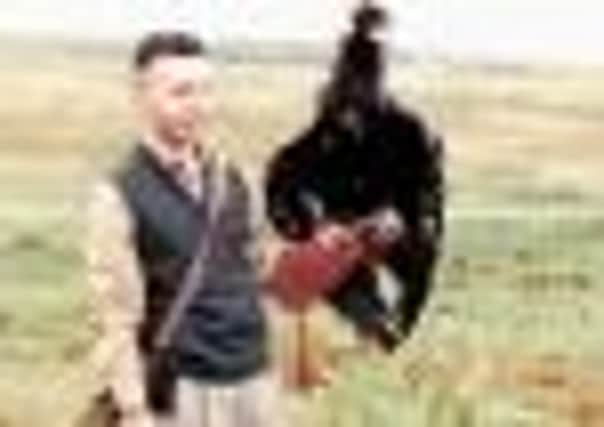Where eagles dare in the Dales


For many moorland keepers, they are nothing more than a damn nuisance, in that they harbour various types of vermin which, in turn, make their job even more difficult.
In all probability, it’s the fact that these areas are not keepered which makes for their continued existence. The other single most influential factor is the effect of years of heavy grazing pressure from sheep.
Advertisement
Hide AdAdvertisement
Hide AdFor the vast majority of people, these areas must appear an almost dismal, lifeless, even forbidding place. Yet for those of us who take a year-round interest, they are anything but. They are alive with a wealth of flora and fauna seldom found elsewhere. It is all hidden away within the white grass, waiting to be found.
For us, one worthwhile side-effect is that it’s the grasses, not the heather, which proliferates – and so does the number of rabbits. And for the past 20 years, we have specialised in flying our hawks for them.
Not only do rabbits provide such wonderful sport, but also they make great eating for the hawks, the dogs and ourselves.
There is virtually nothing about a rabbit that cannot be utilised in one way or another, and I have flown a variety of hawks in pursuit of them.
Advertisement
Hide AdAdvertisement
Hide AdJust as is the case with our dogs, each hawk is as individual in its likes and dislikes from another. Some develop certain eccentricities.
For two years, we flew an Australian wedge-tailed eagle, which we named Edna, after the Barry Humphries’ character. Edna possessed that typical Aussie attitude to life and she dealt with it on her own laid-back terms.
One day, this eagle was the greatest hunting bird in the world. The next, she was the Dales’ largest scavenger. It all depended on her frame of mind on any given day.
For whatever reason, Edna developed an absolute hatred for the colour black. While out flying her around home, she would suddenly fold into a blistering stoop and land on bales of silage wrapped in black plastic which she systematically set about ripping to shreds. It was hardly something that endeared me to our farming friends.
Advertisement
Hide AdAdvertisement
Hide AdAt home, Edna would sit on her perch in our garden not too far from my wife’s washing line where, one day, she pegged out a pair of her black leggings. They blew free and landed within a leash length of the eagle who took up this golden opportunity first to rip them and taste them and then finally to eat them, zip and all.
On collecting the washing, my wife enquired if I had seen the leggings anywhere. I hadn’t.
Edna was free-lofted of an evening within a large stone barn adjacent to our home and when she went to bed that night I was struck by the sheer size of her crop. It was huge, far too big for the amount of food I had allowed her. I thought if the leggings were cotton, a natural material, the acids in the Edna’s stomach would break them down. Indigestible pieces would be passed back up to the crop by morning to be expelled as a casting.
A somewhat restless night followed and, at first light I was up and out to check on Edna. Her crop should have been empty. It wasn’t, still the very size as the night before. Worrying. Fortunately, we were blessed with a vet who is a world authority on birds of prey, Nigel Harcourt Brown, whose practice was in Harrogate.
Advertisement
Hide AdAdvertisement
Hide AdAn appointment was made, the history given and I handed Edna over into his care, while we spent the day shopping. Edna was sedated, x-rayed, and operated upon.
We were greeted on our return to the surgery with Nigel holding a still slightly groggy, half-sedated eagle in one arm, and a very smelly kidney dish full of partly digested legging in the other. They were 95 per cent man-made and would have killed Edna, who was almost 30 years old, if left inside. Edna also made a television appearance. This was the year of the Rugby World Cup, and the then Scottish captain, Rob Wainwright, a doctor at the military hospital in Catterick Garrison, also shared with me a passion for dogs and hawks.
Rob asked if he could include Edna in an interview he was giving to the BBC and their Rugby pundit, Eddie Butler. I was only too happy to oblige, after all, Edna was an Aussie, and her home country was being hotly tipped for honours.
Rob, Eddie and the film crew arrived. I handed over Edna, who was hooded to Rob and the interview commenced.
Advertisement
Hide AdAdvertisement
Hide AdPart-way through the interview, Rob was requested to remove the hood off of Edna so they could see her in all of her glory.
What no-one thought of was that the large fur-covered microphone they were using bore and uncanny resemblance to a rabbit.
Edna, after regaining her bearings, looked straight at what she considered to be an airborne rabbit.
She threw out one of her long legs and grabbed the microphone, tearing it out of the sound recorder’s hand.
She wrestled him to the floor and took possession of her prize.
Eventually, the microphone was retrieved a little worse for wear and the interview was concluded.